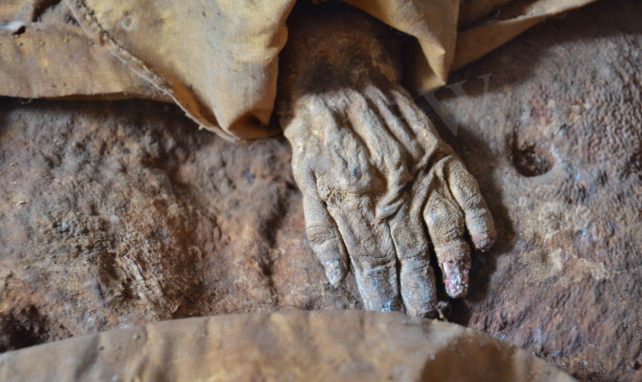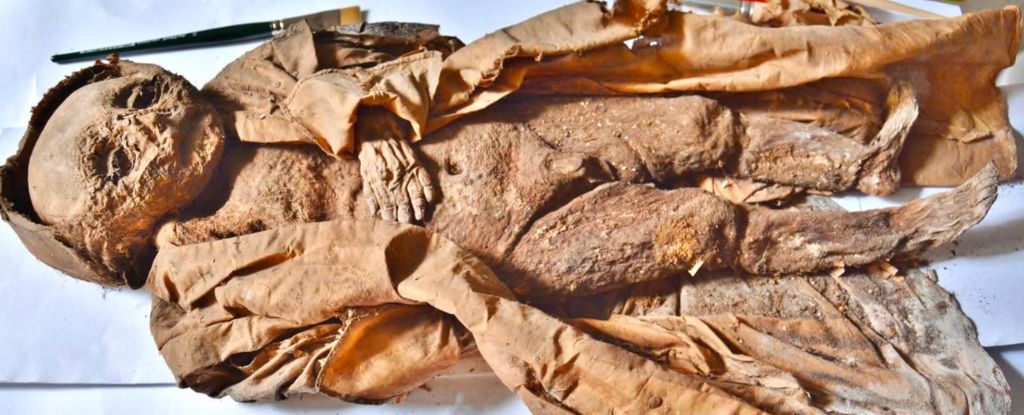Products You May Like
For centuries, the crypt of one of the oldest aristocratic families in Austria has preserved a tragic secret. A boy, perhaps no older than a year or two in age, who died not from a lack of food, or injury. But for a simple want of sunlight on his skin.
The male child was found mummified in a family crypt reserved for the Counts of Starhemberg, having been interred there somewhere between the middle of the 16th and 17th centuries. His tiny features are withered but detailed, his body still wrapped in an elaborate silk garment.
Yet, in spite of living a life of privilege, his short existence was clearly not a healthy one.
A virtual autopsy of the corpse using CT scans has revealed malformations to the ribs that resemble classical signs of malnutrition, specifically vitamin D deficiency. Known as rickets, this condition tends to result in a bowing of the legs, a feature that wasn’t evident in the boy’s bones.
Keeping an open mind, the researchers considered a second possibility – low amounts of vitamin C, resulting in scurvy. While the rib deformations aren’t identical for both conditions, their similarities were enough for the researchers to investigate further.
Fat tissue analysis revealed the 10- to 18-month-year-old was overweight for his age, at least compared to other infants of the time. As a result, researchers suspect the child was well-fed in his patrician life, making vitamin C deficiency less likely.
Vitamin D, on the other hand, isn’t absorbed from our food in significant amounts, but rather produced in the skin through chemical reactions that depend on ultraviolet (UV) radiation, suggesting the child was severely undernourished not for want of food, but by lack of sunlight.
The chemical is absolutely crucial in building bones during childhood, explaining the bone abnormalities. It also allows the body to better absorb calcium and phosphorous throughout life.
“The combination of obesity along with a severe vitamin deficiency can only be explained by a generally ‘good’ nutritional status along with an almost complete lack of sunlight exposure,” explains pathologist Andreas Nerlich from the University of Munich.
Although rickets isn’t necessarily a death sentence, a look at the child’s lungs revealed signs of lethal pneumonia, an infection that is common in infants with vitamin-D deficiencies.

It took until the nineteenth century and a pandemic of rickets for scientists to figure out that Sun exposure is necessary for bone formation, much too late to help the Starhemberg infant.
The mummified infant found in Austria is just one child from one time in one family in one part of Europe, but given how few infant burials have been found so well-preserved, the discovery is an interesting insight into the living conditions of noble infants of the 16th and 17th centuries.
During this time, aristocrats often avoided the Sun to keep their skin porcelain white, a sign of high rank in much of European society. Only peasants and laborers were Sun-kissed.
In Italy, many skeletons of noble children buried in the Medici Chapels in Florence during the 16th and 17th centuries also show signs of rickets, including bowing of the limbs. Researchers behind a 2013 study argue that prolonged delay in providing adequate amounts of solid foods that would provide small amounts of vitamin D in infants could add to risks of rickets.
It’s not clear if the infant found in the Austrian crypt was weaned, or ate fatty foods rich in vitamin D. What is known is he was well-fed and cared for. In fact, his high level of body fat is probably what has kept his remains so well preserved. There’s even some recent evidence that vitamin-D deficiency is tied to childhood obesity, raising questions of just what role his privileged diet might have played in his illness.
Given that the corpse was buried in a silk funerary coat and was the only infant in the family crypt, researchers suspect he was a firstborn, possibly named Gundaker, Gregor, or Reichard, judging by the family tree. Unfortunately, his coffin did not bear an inscription.
“This is only one case,” admits Nerlich, “but as we know that the early infant death rates generally were very high at that time, our observations may have considerable impact in the over-all life reconstruction of infants even in higher social classes.”
The study was published in Frontiers.
